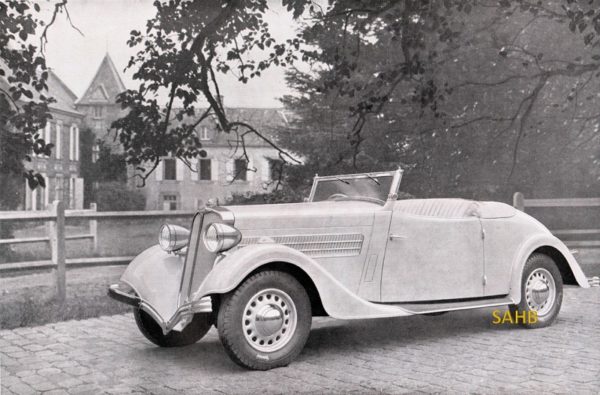
The Salmson company’s distinguished and varied history started in 1890 when Émile Salmson created a workshop in Paris to make steam-powered compressors and centrifugal pumps for railways and the military. By 1896 the factory was building petrol-powered lifts and motors. Salmson were early entrants into the aero-engine market during World War I; after the war their search for peace-time work led them firstly to make car bodies and then complete cars. Car production ceased in 1957 and the company reverted to the pump manufacture that they continue today in Chatou and Laval.
The first cars were built under licence from GN in Salmson’s Billancourt factory, with six examples displayed at the 1919 Paris Salon – but the first true Salmson was powered by a 4-cylinder engine designed by Emile Petit, with remarkable Monoculbuteur (single-rocker) valve gear that used only one pushrod per cyclinder. This pushed open the exhaust valves and springs opened the inlets.
In 1921 the company built their first twin-cam engine; a layout that would endure to the end of car production. They were successful in racing between 1921 and 1928, then turned entirely to road cars. The long-lived S series started in 1929 and ended in 1951 – and our Snapshot shows an S4 DA from 1937.
The S Series was launched in October 1928 at the Paris Salon. It had a small twin-cam 6-cylinder 9 CV engine and could only be distinguished from Salmson’s existing 4-cylinder cars by the “Six” logo in the centre of the radiator grille. 1929 was an inauspicious year to go upmarket in this way and the S did not sell well – but it was the forerunner of the much more successful S4 that appeared with a 1,465cc 4-cylinder engine and classic 4-speed manual transmission in 1932. From May 1934 a Cotal electromechanical gearbox could be specified at extra cost.
The S4 D was introduced in 1934 with a larger engine of 1,596cc, and in 1936 came the S4 DA with 1,731cc capacity, an improved design of hemispherical combustion chamber and centrally positioned spark plugs, making the car noticeably more responsive than others of this engine size. By this time the S4 had also gained independent front suspension. It was priced approximately 50% above a Peugeot 302 with similar specification – a figure that illustrates the Salmson’s relatively exalted position in the 10CV tax-band market.
At the outbreak of World War II the S4 was too complex to interest the French military and the factory was too small to move over to war production. However, the car division survived post-war, initially making modernised versions of the S4 and ultimately the 2300 S launched in 1953. Car production ceased in 1957 and Renault bought the factory.
Picture courtesy of the Richard Roberts Archive







Leave a Comment